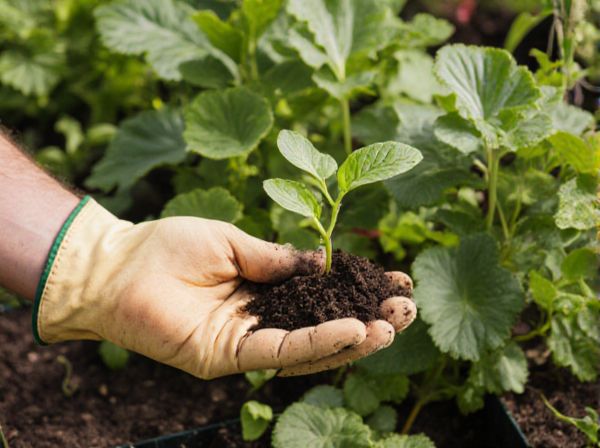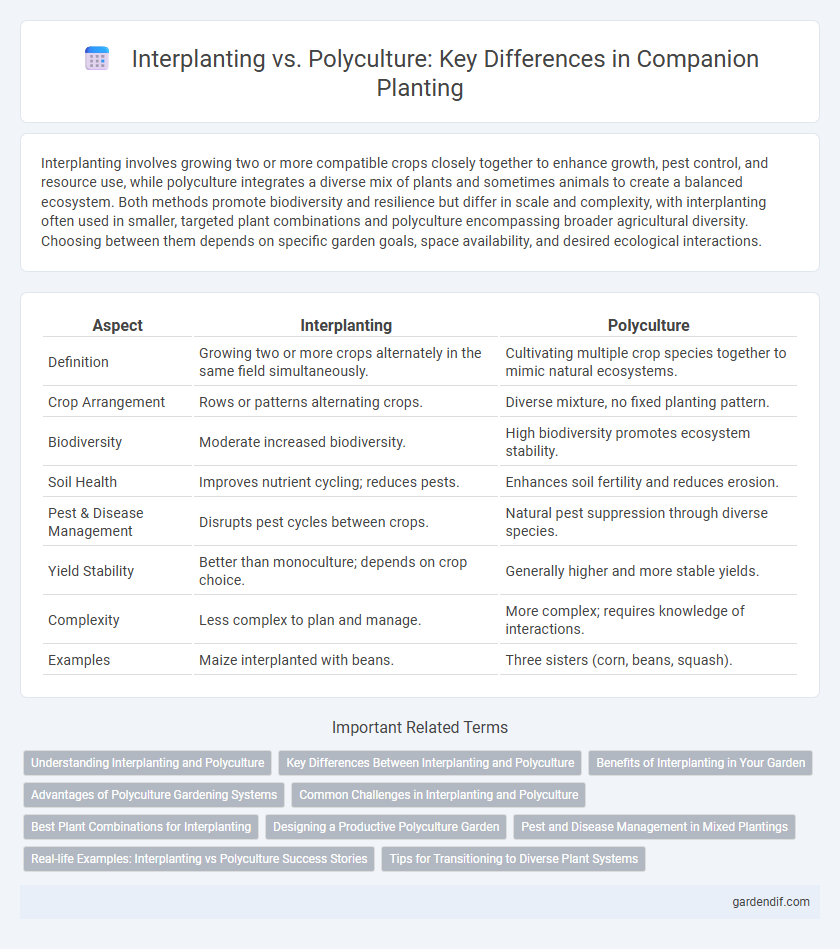
Interplanting vs Polyculture Illustration
Interplanting involves growing two or more compatible crops closely together to enhance growth, pest control, and resource use, while polyculture integrates a diverse mix of plants and sometimes animals to create a balanced ecosystem. Both methods promote biodiversity and resilience but differ in scale and complexity, with interplanting often used in smaller, targeted plant combinations and polyculture encompassing broader agricultural diversity. Choosing between them depends on specific garden goals, space availability, and desired ecological interactions.
Table of Comparison
| Aspect | Interplanting | Polyculture |
|---|---|---|
| Definition | Growing two or more crops alternately in the same field simultaneously. | Cultivating multiple crop species together to mimic natural ecosystems. |
| Crop Arrangement | Rows or patterns alternating crops. | Diverse mixture, no fixed planting pattern. |
| Biodiversity | Moderate increased biodiversity. | High biodiversity promotes ecosystem stability. |
| Soil Health | Improves nutrient cycling; reduces pests. | Enhances soil fertility and reduces erosion. |
| Pest & Disease Management | Disrupts pest cycles between crops. | Natural pest suppression through diverse species. |
| Yield Stability | Better than monoculture; depends on crop choice. | Generally higher and more stable yields. |
| Complexity | Less complex to plan and manage. | More complex; requires knowledge of interactions. |
| Examples | Maize interplanted with beans. | Three sisters (corn, beans, squash). |
Understanding Interplanting and Polyculture
Interplanting involves growing two or more crop species simultaneously in close proximity to maximize space and resource use, enhancing pest control and soil fertility. Polyculture integrates diverse crops and sometimes livestock within the same area, promoting ecosystem resilience and reducing vulnerability to pests and diseases. Understanding these methods aids in sustainable agriculture by optimizing biodiversity and improving overall productivity.
Key Differences Between Interplanting and Polyculture
Interplanting involves growing two or more crop species in close proximity within the same planting area, often arranged in rows or specific patterns to maximize space and resource use. Polyculture, on the other hand, refers to the practice of cultivating multiple crop species together more broadly, mimicking natural ecosystems to enhance biodiversity and reduce pests. Key differences include the scale of species diversity and planting design, with interplanting focusing on strategic pairings for immediate benefits, while polyculture promotes a complex, sustainable agricultural system.
Benefits of Interplanting in Your Garden
Interplanting enhances garden productivity by maximizing space and improving plant health through strategic pairing of compatible species. This method promotes natural pest control as certain plants repel harmful insects, reducing the need for chemical interventions. Diverse root structures improve soil fertility and moisture retention, leading to a more resilient and sustainable garden ecosystem.
Advantages of Polyculture Gardening Systems
Polyculture gardening systems offer enhanced biodiversity, leading to improved pest control and reduced disease incidence compared to monoculture or interplanting methods. This diversity promotes soil health through varied root structures and nutrient uptake patterns, resulting in greater resilience and sustainable productivity. Increased habitat complexity in polyculture attracts beneficial insects and pollinators, boosting overall garden ecosystem stability and yield.
Common Challenges in Interplanting and Polyculture
Common challenges in interplanting and polyculture include competition for light, nutrients, and water among different plant species, which can hinder growth and yield. Managing pest and disease outbreaks becomes more complex due to diverse crop interactions, requiring integrated pest management strategies. Soil nutrient depletion and uneven resource allocation also pose difficulties, demanding careful planning and monitoring to maintain soil health and productivity.
Best Plant Combinations for Interplanting
Best plant combinations for interplanting maximize space and promote mutual growth by pairing complementary species such as tomatoes with basil or carrots with onions. Interplanting leverages the specific benefits of companion plants, like pest deterrence and nutrient sharing, to enhance overall yield and soil health. Selecting compatible plants based on growth habits and nutrient needs optimizes interplanting efficiency compared to broader polyculture systems.
Designing a Productive Polyculture Garden
Designing a productive polyculture garden involves strategically interplanting diverse species to mimic natural ecosystems, enhancing biodiversity and resilience. Combining complementary plants such as legumes, herbs, and vegetables improves nutrient cycling, pest control, and overall yield. Emphasizing spatial arrangement and seasonal succession optimizes light, water, and nutrient use efficiency for sustainable productivity.
Pest and Disease Management in Mixed Plantings
Interplanting enhances pest and disease management by creating diverse plant habitats that disrupt pest life cycles and reduce host plant concentration, lowering outbreak risks. Polyculture systems further increase resilience through complementary plant interactions that improve soil health and natural predator populations, suppressing pests more effectively than monocultures. Both strategies leverage biodiversity to establish ecological balance, minimizing the need for chemical interventions and promoting sustainable crop protection.
Real-life Examples: Interplanting vs Polyculture Success Stories
Interplanting tomatoes with basil has proven successful in reducing pests and enhancing flavor, demonstrating a practical example of companion planting. In contrast, polyculture systems like the traditional Three Sisters method--corn, beans, and squash grown together--showcase sustainable yield improvements and soil health benefits. Both techniques highlight diverse plant interactions that promote ecosystem resilience and agricultural productivity.
Tips for Transitioning to Diverse Plant Systems
Transitioning to diverse plant systems involves gradually integrating polyculture practices by interplanting compatible species that enhance soil health and pest resistance. Select plants with complementary growth patterns and nutrient needs to maximize space and improve biodiversity, promoting a resilient ecosystem. Monitoring plant interactions and adjusting spacing ensures optimal resource use and supports sustainable companion planting strategies.
Interplanting vs Polyculture Infographic

 gardendif.com
gardendif.com